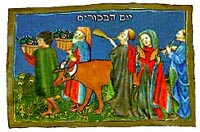|

 The
association between Shavuot and the giving of the Torah is complex.
The biblical name Shavuot, which literally means "weeks", bears no relation
to revelation. It refers to a farmers' festival in ancient times that
concluded the seven weeks of counting begun on the second night of Passover.
Also called Hag ha-Kazir, the "Feast of Harvest", the festival
marked the end of the barley and beginning of the wheat harvest in the
land of Israel. Many would also bring thanksgiving offerings of the
first fruits that had ripened on their trees, giving the festival yet
another name, Yom ha-Bikkurim — "Day of the First Fruits". The
association between Shavuot and the giving of the Torah is complex.
The biblical name Shavuot, which literally means "weeks", bears no relation
to revelation. It refers to a farmers' festival in ancient times that
concluded the seven weeks of counting begun on the second night of Passover.
Also called Hag ha-Kazir, the "Feast of Harvest", the festival
marked the end of the barley and beginning of the wheat harvest in the
land of Israel. Many would also bring thanksgiving offerings of the
first fruits that had ripened on their trees, giving the festival yet
another name, Yom ha-Bikkurim — "Day of the First Fruits".
The Mishnah [Bikkurim] describes a colorful
procession in which farmers from small villages would gather in a
large town to go together to Jerusalem. "Arise, let us go up to Zion,
to the House of our God," the leader  would
announce as they set out on their pilgrimage. When they neared Jerusalem,
flutists would greet them with music, and when they reached the Temple
court, the priests would welcome them with hymns and psalms.How, then,
did these festivities of fruits and grains turn into a celebration
of the Torah? Part of the genius of the talmudic sages was their ability
to overlay old agricultural holidays with historical meaning. In the
case of Shavuot, the rabbis calculated that the festival fell during
the same three-month period in which the Children of Israel had reached
the wilderness of Sinai after leaving Egypt. They fixed the date for
both events as the sixth of Sivan and made the Sinai experience the
essence of the holiday (Jews outside Israel observe the holiday on
the seventh as well). would
announce as they set out on their pilgrimage. When they neared Jerusalem,
flutists would greet them with music, and when they reached the Temple
court, the priests would welcome them with hymns and psalms.How, then,
did these festivities of fruits and grains turn into a celebration
of the Torah? Part of the genius of the talmudic sages was their ability
to overlay old agricultural holidays with historical meaning. In the
case of Shavuot, the rabbis calculated that the festival fell during
the same three-month period in which the Children of Israel had reached
the wilderness of Sinai after leaving Egypt. They fixed the date for
both events as the sixth of Sivan and made the Sinai experience the
essence of the holiday (Jews outside Israel observe the holiday on
the seventh as well).
Today, reminders of the agricultural basis for Shavuot
appear in the plants and flowers that decorate many synagogues during
the holiday. But even those acquired another meaning — to represent
the green of the mountain from which the Torah was given. In Reform
and Conservative synagogues, the decorations add splendor to confirmation
services, which celebrate the completion of the Hebrew school year
and the graduation of its high-school students.
The mystics instituted a tikkun leil
Shavuot (all-night study session in which congregants read and discuss
passages of the Bible, the Mishnah and Talmud, and mystical writings).
SIVAN Table of Contents
|



